The Maldives, known for its crystal-clear waters and stunning islands, is home to many shark species. While the very mention of sharks might send chills down your spine, it’s a fun exercise to get to know the types that inhabit these tropical waters. In fact, you might be interested to know that many species are quite harmless and used to the sight of humans.
This article dives into the facts about sharks in the Maldives and offers insights into swimming safely in their presence. If you’re gearing up for a Maldivian adventure or simply just curious, we’ve got the answers for you!
1. Blacktip Reef Shark (Carcharhinus melanopterus)

One of the most common shark species you’ll see in the Maldives is the blacktip reef shark.
©Vladimir Wrangel/Shutterstock.com
Blacktip reef sharks are among the frequently seen sharks in the Maldives. At many resorts in the Maldives, it’s not uncommon to see young blacktip reef sharks swimming around.
The name of these sharks comes from the distinct black markings on their fin edges. These sharks have a short, rounded snout and teeth that resemble a saw blade. Their coloration helps them remain hidden, with a dark upper body blending into the shadowy ocean floor and a pale underside reflecting the light from above.
Typically, these sharks aren’t very big. Most measure between 3 to 6 feet in length. Their diet consists mainly of fish, though they also consume crustaceans and various mollusks.
These sharks frequent the shallow coastal areas of the Maldives. Their habitat spans the tropical regions of the Indian Ocean to the central Pacific, mainly near coral reefs and atolls.
Note that blacktip reef sharks can show signs of aggression, especially around food!
2. Grey Reef Shark (Carcharhinus amblyrhynchos)

Another common shark species in the Maldives in the grey reef shark.
©cbpix/iStock via Getty Images
During shark diving expeditions in the Maldives, it’s quite common to encounter the grey reef shark. They are usually spotted in the shallow regions close to the beaches.
This species exhibits the classic, streamlined shape that most people associate with sharks, including an anal fin and five gill openings. Its long and rounded snout positions its mouth beneath its eyes. The eyes of this shark are noticeably round. Its top side showcases a grey hue with a touch of bronze, while its underside is a lighter shade, ranging from pale to white.
They can grow up to a length of 8.3 feet but generally are smaller at around 4 to 5 feet. Their primary diet consists of reef fish, but they also enjoy a variety of squid, octopus, shrimp, and lobster.
Grey reef sharks are frequently seen cruising around shallow coral formations, underwater ledges, and channels, especially in the central and southern parts of the Maldives. They are known to be protective of their territory.
Divers are advised to keep a respectful distance and avoid cornering or touching them. These sharks can be aggressive towards humans!
3. Whitetip Reef Shark (Triaenodon obesus)

Whitetip reef sharks are also commonly seen in the Maldives.
©Rich Carey/Shutterstock.com
The whitetip reef shark is one of the top three sharks you’ll likely see in the Maldives, along with the blacktip and gray reef sharks.
Whitetip reef sharks are easy to identify. They’re slim with a short, flat nose, a wide head with a noticeable ridge above the eyes, and unique oval-shaped eyes on the sides. Their mouths curve down, giving them a sort of serious look.
While they can grow up to 7 feet, most of them are about 5 feet long. During nighttime, these sharks get busy searching for food, hunting creatures that hide in the reef’s cracks. Their favorite meals include octopuses, small sea creatures, and various reef fish like eels and snappers.
You’ll mainly find them in clear waters near the coast, swimming around coral reefs, sometimes as deep as 100 feet.
Usually, whitetip reef sharks are calm around people. They might swim close out of curiosity, but they’re mostly harmless. However, fishermen should be careful, as these sharks might try to grab their catch.
4. Nurse Shark (Ginglymostoma cirratum)
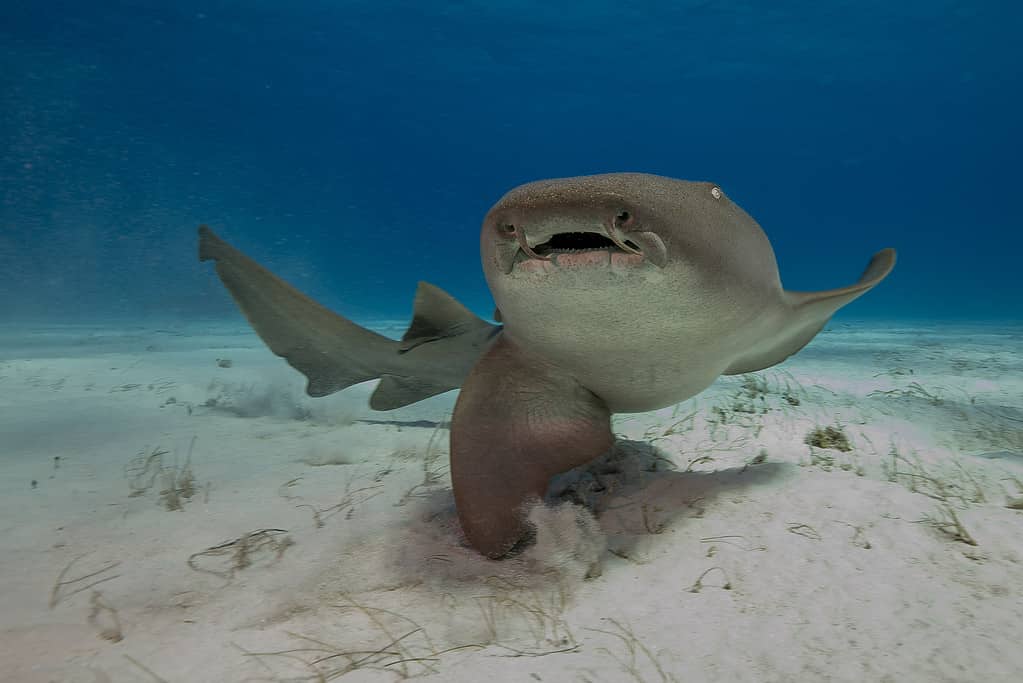
There have been recent instances of nurse sharks attacking humans, but they are not generally aggressive.
©Stevelaycock21 / CC BY-SA 4.0 – License
In the Maldives, nurse sharks usually hide during daylight hours and become active hunters when it’s dark.
These sharks have a sandy brown shade, often with tiny dark marks. Their bodies are flat, and their heads are wide and round. They also have two feeler-like barbels near their nostrils, which they use to search for food. Their mouths are packed with tiny, jagged teeth that help them eat hard-shelled creatures.
Female nurse sharks are a bit larger than males, typically measuring between 7.5 to 9 feet. Their diet mostly consists of creatures found on the ocean floor, like stingrays, crabs, and lobsters, but they also eat squid and urchins.
You can find nurse sharks in many parts of the Indo-Pacific area, including places like India and Indonesia. In the Maldives, they prefer shallow waters around coral reefs, especially between 30 to 135 feet deep during periods of low tide.
Compared to other sharks, nurse sharks are seen as less dangerous. They’re peaceful and move slowly. They usually don’t pose a threat to humans. However, it’s good to remember that any shark can become dangerous if it feels cornered or bothered.
5. Tiger Shark (Galeocerdo cuvier)
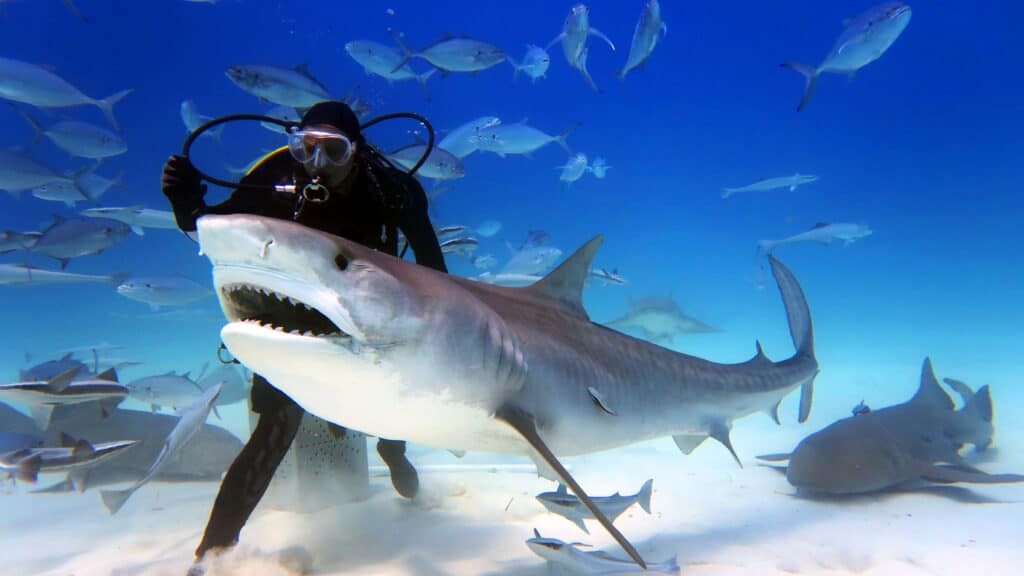
You can see
tiger
sharks on Fuvahmulah Island in the Maldives!
©HQuality/Shutterstock.com
Lately, Fuvahmulah Island has become a hotspot for those interested in diving with tiger sharks.
The tiger shark has a broad head, a mouth that extends past its short snout, and a streamlined body. Its tail is distinctively long and pointed, and its teeth have a unique curved shape with jagged sides and a little notch.
This shark is among the larger species, generally growing up to 18 feet. They have a diverse diet, munching on fish, other sharks, dolphins, turtles, and even birds. Sometimes, they even swallow things that aren’t meant to be eaten, such as plastic and license plates.
Situated in the southern Maldives, Fuvahmulah is home to the tiger sharks. Recognized by UNESCO as a biosphere reserve, this island is often called Asia‘s Shark Hub. Its location, surrounded by the deep waters of the Indian Ocean, draws diverse marine life, including numerous sharks, throughout the year.
While tiger sharks rank second only to the great white in terms of danger, there’s no known record of any shark-related incidents in the Maldives. With that said, these sharks might approach divers out of curiosity.
6. Zebra Shark (Stegostoma tigrinum)
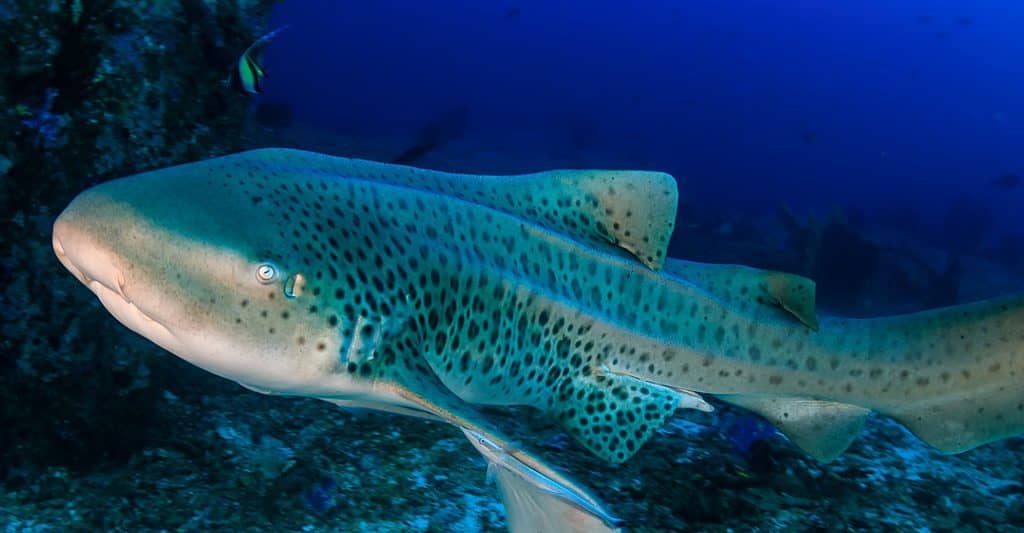
While not as common as other sharks, zebra sharks can be spotted in the Maldives as well.
©iStock.com/WhitcombeRD
Not as common as the blacktip and whitetip reef sharks, you can still come across the zebra shark in the Maldives.
When they’re young, zebra sharks sport dark bodies with light stripes. But as they grow older, their appearance shifts, with their bodies becoming light with dark spots, leading some to also call them leopard sharks. But note that leopard sharks are an entirely different species!
Some zebra sharks can grow close to 12 feet. However, most are around 7.5 feet or smaller. They love munching on small sea creatures like mollusks, crustaceans, and little fish. Their agile bodies let them wiggle into tight spaces in the reef to find their meals.
You’ll find these sharks swimming in the warm waters around the Maldives, often near coral reefs, sandy patches, and underwater debris. They usually stay close to the ocean floor, sometimes as deep as 200 feet.
Zebra sharks are calm and move slowly. They aren’t generally a threat to swimmers. But there have been instances where divers who tugged at their tails or tried to ride them got bitten. It’s always best to observe without disturbing.
7. Whale Shark (Rhincodon typus)
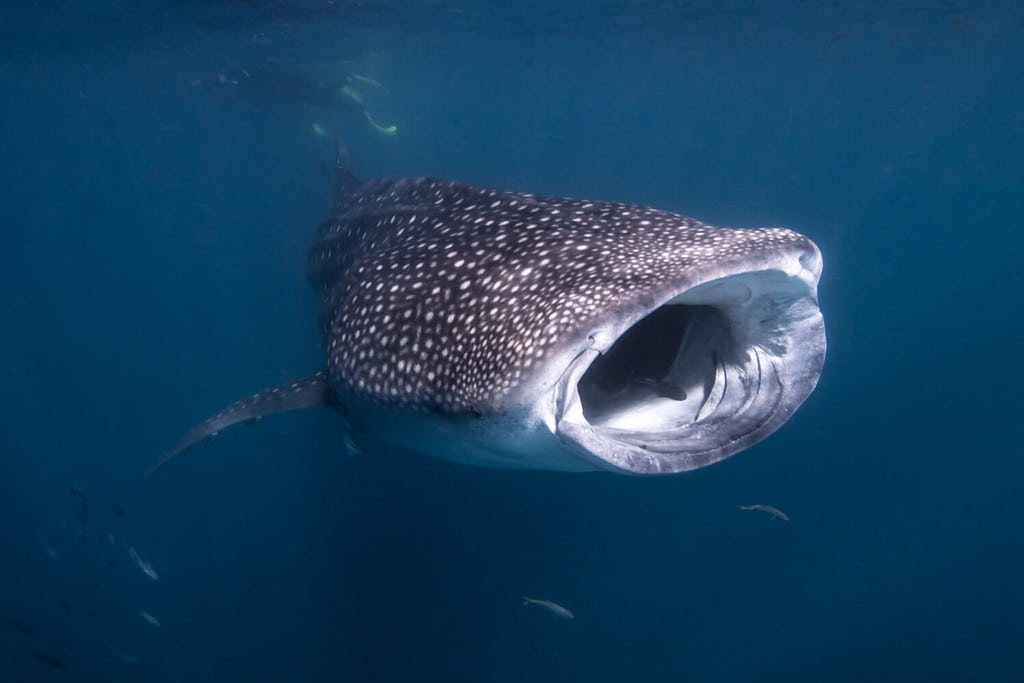
One of the most fascinating and awe-inspiring sea creatures in the Maldives is the whale shark.
©Sean Steininger/Shutterstock.com
The Maldives boasts a diverse array of marine life, and among its most awe-inspiring residents is the whale shark.
Unlike many other sharks, the whale shark’s broad mouth is positioned right at the front of its head. They’re easily recognized by their expansive, flat heads, rounded noses, tiny eyes, and five prominent gill slits, along with two dorsal and two pectoral fins.
These magnificent creatures are marked as endangered. They can stretch beyond 40 feet and have quite an extensive dietary range. But, much to the relief of other marine life—and us too—their preferred snack is tiny plankton.
These sharks are often seen in a variety of marine environments in the Maldives, from deep waters to shallow lagoons and coral-rich areas.
A reassuring fact for marine enthusiasts: whale sharks are gentle souls. They’re non-aggressive and are quite indifferent to human presence, allowing divers to swim alongside without concern.
8. Great White Shark (Carcharodon carcharias)

If you’re lucky, or rather, unlucky, you might spot a great white shark in the Maldives.
©Martin Prochazkacz/Shutterstock.com
Among the migratory sharks visiting the Maldives, the great white shark tops the list.
The name “great white” comes from their pale bellies, while their upper parts range from browns to grays. This dual-toned appearance, known as countershading, helps many marine species camouflage in the ocean. Great whites have a streamlined shape, and their strong tails can thrust them at speeds up to 35 miles per hour.
Younger great whites often feast on fish, rays, and small sea creatures. As they grow bigger, their diet expands to include seals, dolphins, sea birds, turtles, and even other sharks.
You can find these sharks near the coast as well as in deeper, open waters.
Being at the top of the food chain, there’s hardly any marine life that can challenge a great white in strength and power. While they generally don’t target humans, misidentifying a person as prey is a primary reason for any aggressive behavior.
9. Silky Shark (Carcharhinus falciformis)
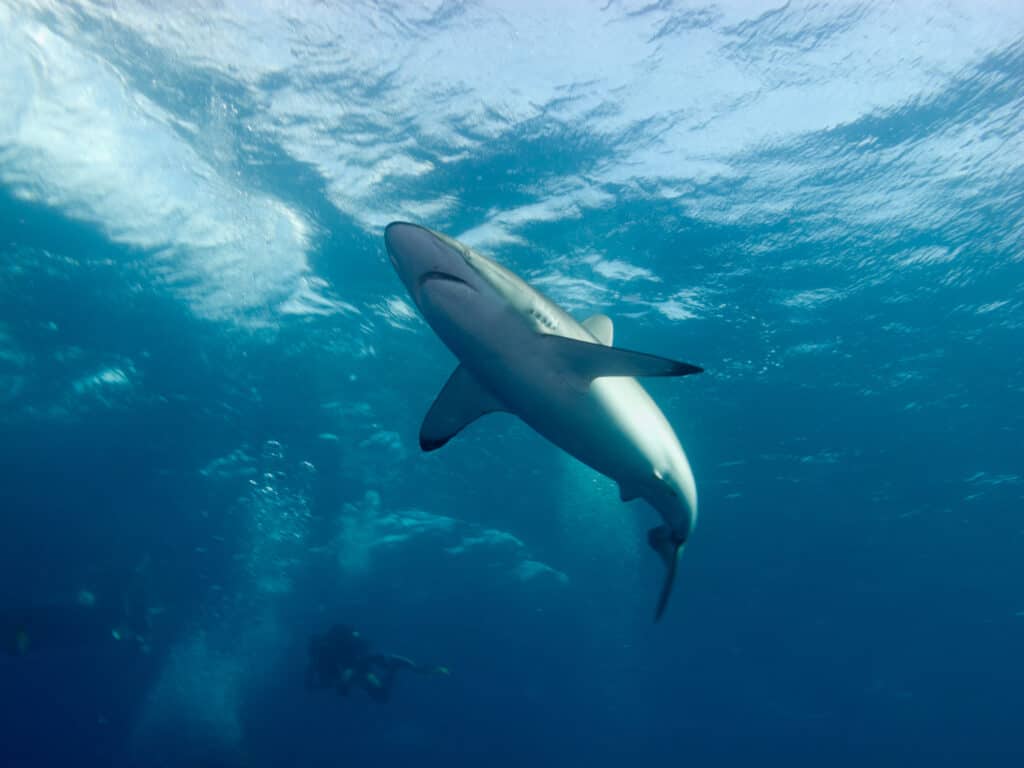
Found in warm waters around the world, silky sharks swim around the Maldives.
©Sergey Dubrov/Shutterstock.com
Silky sharks are known for their speed and hunting skills, often chasing bigger prey in the vast ocean. But in the Maldives, it’s usually the younger ones or the baby sharks that are seen staying close to the protective reefs of the atolls.
This shark species is sleek, with a distinctive ridge between its dorsal fins. Its long side fins and uniquely shaped tail stand out. On closer look, you’ll notice its upper jaw has sharp, triangular teeth.
Among its kind, the silky shark is one of the larger species, often growing up to 8.2 feet. Some have even been recorded at a length of 11 feet. They’ll eat a mix of prey from different parts of the ocean, including red crabs, tuna, and even porcupine fish.
You’ll find silky sharks in warm waters spanning the Atlantic, Pacific, and Indian oceans.
Given their size and sharp teeth, silky sharks can be intimidating. They’ve also shown some aggression towards divers on occasion. However, actual attacks are uncommon since not many people venture into the deeper parts of their territory.
10. Smooth Hammerhead Shark (Sphyrna zygaena)

The smooth hammerhead shark is a must-see for diving enthusiasts in the Maldives.
©iStock.com/Michael Zeigler
The Maldives is a top spot globally for diving enthusiasts keen on seeing hammerheads!
What sets the smooth hammerhead shark apart from its cousins, like the scalloped and great hammerhead, is its uniquely rounded head. This shape provides them with an unparalleled view, allowing them to see everything around them, both above and below.
Among the hammerheads, the smooth variety is on the larger side, typically measuring between 8 and 11.5 feet.
These sharks aren’t picky eaters. They’ll consume a range of sea creatures, from dolphins to skates, rays, and even octopuses. Interestingly, they’ve also been known to eat smaller sharks of their own kind.
While they can be found in most warm seas, they’re not too common in tropical regions. They have a preference for shallower waters, often staying within 65 feet of the surface.
It’s worth noting that there have been reports of smooth hammerheads behaving aggressively toward humans, so caution is advised.
11. Scalloped Hammerhead Shark (Sphyrna lewini)

You may also spot the scallopped hammerhead in the Maldives.
©Ian Scott/Shutterstock.com
The scalloped hammerhead shark is a fascinating and iconic shark species that you may be able to spot in the Maldives.
As evidenced by their name, these sharks are known for their distinctively scalloped-shaped head. This unique head structure gives them exceptional sensory capabilities, allowing them to detect prey more efficiently. They use this advantage to hunt a variety of marine life, including squid, sardines, stingrays, crustaceans, and even other sharks. Scalloped hammerheads typically grow up to 12 feet long.
Despite their intimidating appearance, scalloped hammerheads are not generally considered a threat to humans. They tend to be shy and avoid confrontations with larger animals, including humans. However, like all wild animals, they should be observed from a safe distance as they can be dangerous if provoked.
Is It Safe to Swim in the Maldives?

Don’t worry; it is safe to swim in the Maldives!
©Siraphob Werakijpanich/Shutterstock.com
Swimming and diving in the Maldives are generally safe. Most sharks in the region are peaceful and not dangerous to people. That said, it’s crucial to be cautious and respect local safety guidelines when near these marine creatures.
It’s also important to note that certain parts of the Maldives have strong water currents. It’s wise to get familiar with the area before taking a dip.
The Maldives offers an open-sea experience rather than using cages. To truly enjoy this, good swimming skills are a plus. But even if you’re not a strong swimmer, you can still have a memorable time observing whale sharks and other marine life from above.
What Is the Best Time to Spot Sharks in the Maldives?
Whale sharks are present throughout the year. However, to maximize your chances of seeing other shark species, consider traveling to the Maldives between December and May. During this period, the sea is warm, and the water is clear.
It’s a good idea to skip the monsoon months, as the conditions can be less ideal for spotting marine life.
Where to Spot Sharks in the Maldives
South Ari Atoll, also known as Alifu Dhaalu Atoll, is a prime location in the Maldives for spotting whale sharks. Thanks to the rich plankton in its waters, it’s a hub for these gentle giants all year round.
For those eager to see manta rays and various shark species, Baa Atoll is another ideal place. Particularly during the rainy season from June to October, Hanifaru Bay becomes a magnet for marine enthusiasts. It’s often dubbed the Maldives’ premier shark gathering spot. Baa Atoll offers a range of diving spots suitable for divers of all levels.
Another notable location is Rasdhoo Atoll, particularly Rasdhoo Madivaru. Here, you’ll often encounter hammerhead sharks, earning it the nickname “Hammerhead Point.
Kandooma Thila, commonly referred to as Cocoa Thila, is a highlight on the eastern side of the atoll. This spot isn’t just loved for mantas; divers also get to see grey and whitetip reef sharks.
Fuvahmulah offers an unparalleled diving experience in the Maldives due to its unique position and untouched dive sites. While the atoll’s tiger sharks steal the spotlight, divers might also come across hammerheads, thresher sharks, schools of barracudas, oceanic manta rays, and occasionally even common mola and pilot whales.
Shark Attacks in the Maldives
Shark incidents in the Maldives are rare. In fact, there haven’t been any deadly shark attacks on the islands!
A few recent events include:
- Carmen, a 30-year-old nurse, was bitten by a nurse shark at Vaavu Atoll. She was brave enough to go back into the water after tending to her injury.
- In 2022, a fisherman fell into the water near Maafilaafushi island and got injured by a shark. This was reported by the Maldives National Defence Force (MNDF).
- A bikini model got too near to a nurse shark at Vaavu Atoll in 2023 and got bitten. A video of the event went viral popular online.
It’s vital to remember that these events often occur when people get too close to sharks or don’t follow safety advice. Sharks don’t usually target humans. However, they might defend their space if they feel threatened.
Summary of 10 Sharks Found in the Maldives – Is It Safe to Swim?
| Number | Shark | Scientific Name |
|---|---|---|
| 1 | Blacktip Reef Shark | Carcharhinus melanopterus |
| 2 | Grey Reef Shark | Carcharhinus amblyrhynchos |
| 3 | Whitetip Reef Shark | Triaenodon obesus |
| 4 | Nurse Shark | Ginglymostoma cirratum |
| 5 | Tiger Shark | Galeocerdo cuvier |
| 6 | Zebra Shark | Stegostoma tigrinum |
| 7 | Whale Shark | Rhincodon typus |
| 8 | Great White Shark | Carcharodon carcharias |
| 9 | Silky Shark | Carcharhinus falciformis |
| 10 | Smooth Hammerhead Shark | Sphyrna zygaena |
| 11 | Scalloped Hammerhead Shark | Sphyrna lewini |
The photo featured at the top of this post is © cbpix/iStock via Getty Images
Thank you for reading! Have some feedback for us? Contact the AZ Animals editorial team.






